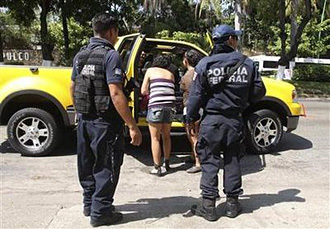
|  |  |  News Around the Republic of Mexico News Around the Republic of Mexico  
Drug Violence Surge Hits Mexico's Iconic Acapulco
 Noel Randewich - Reuters Noel Randewich - Reuters
go to original
April 28, 2010


| | Federal police stand guard as a vehicle undergoes a check at the Mexican beach resort of Acapulco April 25, 2010. (Reuters/Jesus Trigo) |  |
Acapulco, Mexico - Violent drug gangs are terrorizing Mexico's famed Acapulco beach resort, with hitmen shooting at rivals on the hotel strip and dumping beheaded bodies in a battle for control of the port city.

Bloodshed has jumped in the area, a flashpoint in President Felipe Calderon's drug war, since troops killed cartel kingpin Arturo Beltran Leyva in December, triggering a power struggle within his organization.

Hitmen have been deployed in Acapulco, a playground for Hollywood stars in the 1950s, as two would-be leaders of the Beltran Leyva gang vie for control of smuggling routes from the Pacific coast to Mexico City and the U.S. border, federal police and analysts say.

A broad daylight shootout on Acapulco's main strip earlier this month killed six people, including three bystanders, forcing cars to swerve out of control and causing tourists to dive for cover along a palm-tree lined boulevard.

"It was like we were in the middle of a war on the main tourist strip. That's just not right," said Celso Sanchez, the director of a private school that saw two of its pupils shot dead in the cross-fire.

Surging violence, also visible in the colonial getaway town of Cuernavaca on the road from Mexico City to Acapulco, has pressured the tourism industry across Mexico as well as adding to the worries of foreign investors.

Acapulco's older hotels, once exclusive getaways for millionaires and stars like Frank Sinatra, John Wayne and Rita Hayworth, have struggled to compete with newer and flashier all-inclusive rivals in the Caribbean and Baja California.

Since a highway was built in the 1990s to connect the town to Mexico City, Acapulco has seen a boom in Mexican tourists. But they spend much less than foreigners who now tend to prefer beach resorts like Los Cabos or Puerto Vallarta.

The number of tourists flying into Acapulco fell by almost a fifth in the first three months of 2010, according to airport operator OMA.

"WE CAN'T LIE"

Mexico is a top tourist destination, with more than 20 million annual visitors. Tourism makes up 8 percent of its economy.

Acapulco business owners are desperate to assure visitors that their city of more than a million people is safe.

"Obviously we can't lie and say nothing is happening when you can see the number of dead on the news," said Pedro Falcon, a representative of local travel agencies. "But we have to keep working despite the crisis, not let fear or panic take over."

Calderon has staked his presidency on crushing drug gangs, whose turf wars and clashes with security forces have killed some 23,000 people since he took power in 2006. His deployment of 70,000 troops and police has led to more violence.

The killings in Acapulco and Cuernavaca result from a leadership battle between Hector Beltran Leyva - the dead kingpin's brother - and Edgar "La Barbie" Valdez, U.S. security firm Stratfor said in a report, citing sources close to the cartel.

"The once-powerful organization is now split in two, with the cartel's enforcers united under Valdez Villareal and with Beltran Leyva family loyalists united under Hector," it said.

Local residents say that some SUV owners in Acapulco make sure to keep their tinted windows fully down to avoid being mistaken for drug war combatants.

Heavily armed soldiers in body armor and helmets patrol Acapulco's baking hot streets, where shops sell bikinis, ice cream and other tourist merchandise.

"That creates two senses - a sense of intimidation and a sense of security, and I'm not quite sure which one is winning out at the moment," said Stephen Hanlon, who was on a business trip from Australia.

"I wouldn't choose to come here for a holiday," he added.

Acapulco is where 16th-century Spanish trade galleons unloaded spices and other treasures from Manila. Now the port is an entry point for U.S.-bound cocaine and a market in its own right, with $20 bags of the drug sold to tourists and locals.

Cruise ship visitors are warned about violence. Comforted by the heavy police presence, many still disembark to visit the port's historic fort and its cliff divers.

"I like to see them try to make things safer. This is their economy, this is tourism. They've got to keep us in good shape or we are not going to come," said Bob Jensen from Florida.

(Additional reporting by Tomas Sarmiento and Mica Rosenberg in Mexico City; Editing by Robin Emmott, Catherine Bremer and Paul Simao)
|

 |
|  |



